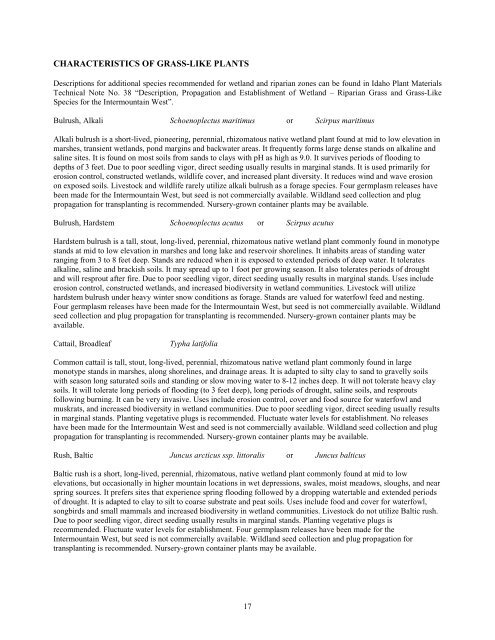Idaho Plant Materials Technical Note No. 24
Idaho Plant Materials Technical Note No. 24
Idaho Plant Materials Technical Note No. 24
Create successful ePaper yourself
Turn your PDF publications into a flip-book with our unique Google optimized e-Paper software.
CHARACTERISTICS OF GRASS-LIKE PLANTS<br />
Descriptions for additional species recommended for wetland and riparian zones can be found in <strong>Idaho</strong> <strong>Plant</strong> <strong>Materials</strong><br />
<strong>Technical</strong> <strong><strong>No</strong>te</strong> <strong>No</strong>. 38 “Description, Propagation and Establishment of Wetland – Riparian Grass and Grass-Like<br />
Species for the Intermountain West”.<br />
Bulrush, Alkali Schoenoplectus maritimus or Scirpus maritimus<br />
Alkali bulrush is a short-lived, pioneering, perennial, rhizomatous native wetland plant found at mid to low elevation in<br />
marshes, transient wetlands, pond margins and backwater areas. It frequently forms large dense stands on alkaline and<br />
saline sites. It is found on most soils from sands to clays with pH as high as 9.0. It survives periods of flooding to<br />
depths of 3 feet. Due to poor seedling vigor, direct seeding usually results in marginal stands. It is used primarily for<br />
erosion control, constructed wetlands, wildlife cover, and increased plant diversity. It reduces wind and wave erosion<br />
on exposed soils. Livestock and wildlife rarely utilize alkali bulrush as a forage species. Four germplasm releases have<br />
been made for the Intermountain West, but seed is not commercially available. Wildland seed collection and plug<br />
propagation for transplanting is recommended. Nursery-grown container plants may be available.<br />
Bulrush, Hardstem Schoenoplectus acutus or Scirpus acutus<br />
Hardstem bulrush is a tall, stout, long-lived, perennial, rhizomatous native wetland plant commonly found in monotype<br />
stands at mid to low elevation in marshes and long lake and reservoir shorelines. It inhabits areas of standing water<br />
ranging from 3 to 8 feet deep. Stands are reduced when it is exposed to extended periods of deep water. It tolerates<br />
alkaline, saline and brackish soils. It may spread up to 1 foot per growing season. It also tolerates periods of drought<br />
and will resprout after fire. Due to poor seedling vigor, direct seeding usually results in marginal stands. Uses include<br />
erosion control, constructed wetlands, and increased biodiversity in wetland communities. Livestock will utilize<br />
hardstem bulrush under heavy winter snow conditions as forage. Stands are valued for waterfowl feed and nesting.<br />
Four germplasm releases have been made for the Intermountain West, but seed is not commercially available. Wildland<br />
seed collection and plug propagation for transplanting is recommended. Nursery-grown container plants may be<br />
available.<br />
Cattail, Broadleaf<br />
Typha latifolia<br />
Common cattail is tall, stout, long-lived, perennial, rhizomatous native wetland plant commonly found in large<br />
monotype stands in marshes, along shorelines, and drainage areas. It is adapted to silty clay to sand to gravelly soils<br />
with season long saturated soils and standing or slow moving water to 8-12 inches deep. It will not tolerate heavy clay<br />
soils. It will tolerate long periods of flooding (to 3 feet deep), long periods of drought, saline soils, and resprouts<br />
following burning. It can be very invasive. Uses include erosion control, cover and food source for waterfowl and<br />
muskrats, and increased biodiversity in wetland communities. Due to poor seedling vigor, direct seeding usually results<br />
in marginal stands. <strong>Plant</strong>ing vegetative plugs is recommended. Fluctuate water levels for establishment. <strong>No</strong> releases<br />
have been made for the Intermountain West and seed is not commercially available. Wildland seed collection and plug<br />
propagation for transplanting is recommended. Nursery-grown container plants may be available.<br />
Rush, Baltic Juncus arcticus ssp. littoralis or Juncus balticus<br />
Baltic rush is a short, long-lived, perennial, rhizomatous, native wetland plant commonly found at mid to low<br />
elevations, but occasionally in higher mountain locations in wet depressions, swales, moist meadows, sloughs, and near<br />
spring sources. It prefers sites that experience spring flooding followed by a dropping watertable and extended periods<br />
of drought. It is adapted to clay to silt to coarse substrate and peat soils. Uses include food and cover for waterfowl,<br />
songbirds and small mammals and increased biodiversity in wetland communities. Livestock do not utilize Baltic rush.<br />
Due to poor seedling vigor, direct seeding usually results in marginal stands. <strong>Plant</strong>ing vegetative plugs is<br />
recommended. Fluctuate water levels for establishment. Four germplasm releases have been made for the<br />
Intermountain West, but seed is not commercially available. Wildland seed collection and plug propagation for<br />
transplanting is recommended. Nursery-grown container plants may be available.<br />
17
















